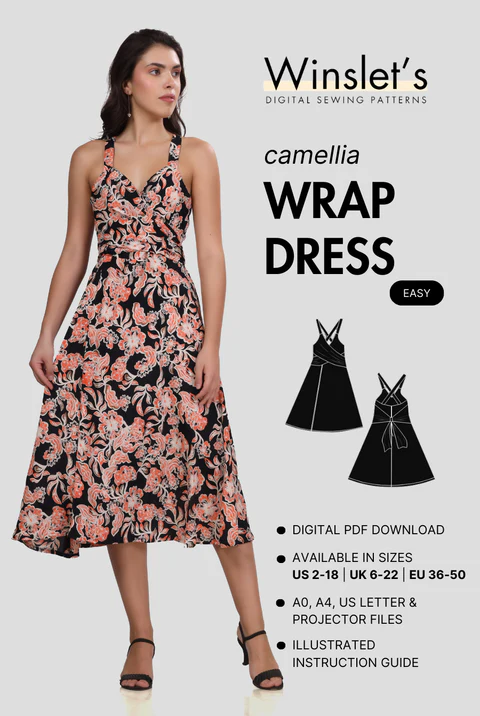Finding the correct sewing patterns is an interesting and demanding task regardless of your level of experience with crafts or simply starting to sew. Millions of designs make it challenging to pick one that fits your ability and flair. Fortunately, sewing patterns are available for both novices and professionals, and so you can get better at your job while having a wonderful time. In this article, we will be exploring sewing patterns that suit any skill level, which ensures that you will learn to sew professionally.
The importance of choosing the right sewing pattern
No matter how much you can sew, it is important to select the right sewing pattern to get the professional look you desire. Inexperienced users will benefit from patterns that are easy to understand and implement in order to gain confidence. Smaller shapes, fewer seams, and less fabric work are things you should expect from beginner patterns. As you level up, you can experiment with new designs, finer details, and more difficult techniques. Sewing patterns that have pleats, darts, or other special closures, for example, are an excellent way to improve your technique.
Sewists who are really proficient may prefer complex designs that can be altered to create their own style of garment. You’ll want to ensure that the pattern is as simple as you can do it and that you won’t be frustrated with a difficult pattern. Selecting custom-tailored patterns will improve your sewing skills and create boutique-quality garments.
Patterns that help build confidence in beginners
To learn the basics, starting with simple patterns and building confidence is essential for a beginner. Simple garments that require very little sewing, or a straightforward top, are excellent starting points to learn some basic stitches. The simple patterns not only teach you how to sew, but also expose you to fabrics, seam allowances, and finishes. Also, novice sewing patterns must include instructions and diagrams in an easy-to-understand format so that the beginner feels confident during the process of sewing.
Once you feel more comfortable with plain patterns, you can gradually add extras, like pockets, zippers, or pleats. These tips will make you feel more confident in sewing and set you up for more challenging projects. If you begin with straightforward pieces of clothing, you will discover that your ability to sew develops naturally, and you can tackle more difficult pieces much faster.
Intermediate patterns for crafting unique and stylish garments
After learning the foundations, intermediate patterns provide a wonderful chance to push yourself and create something more elegant and original. Customized jackets, pleated skirts, or lace-trimmed blouses offer the right mix of skill and innovation. Fabric selection and additional design features can customize these patterns, which tend to be more detailed and complex.
Intermediate sewists might venture into exploring more complex fabrics (silk, wool, denim, etc.) that may need further instruction and methods. Using these fabrics expands your sewing options and increases your quality. Sewing patterns on these fabrics lets you explore new sewing techniques, like lining, bias cuts, or even sewing zippers. When you’re starting to get comfortable with intermediate, you’ll feel more confident and be able to build more advanced designs.
Advanced Sewing Patterns for the Expert Seamstress
Advanced patterns provide more creative and exciting ways to show your talents. They tend to be more elaborate, incorporating intricate details like ruffles, multiple layers, and asymmetrical shapes. Professional sewers can explore couture, experimenting with draping, hand-stitching, and personal embroidery or adornment. Designer clothes such as evening gowns, suiting, and costume designs test your sewing skills and reward you with professional results.
What is wonderful about advanced patterns is that they make your sewing not a craft but an art. You will learn to tailor patterns to your measurements to create flattering and stylish clothing. Furthermore, more complex patterns often require advanced sewing equipment and techniques, so it is a wonderful way to expand your abilities as a seamstress. Be it sewing clothes for yourself or unique designs for someone else, these patterns will leave you with professional sewing skills and the tools to tackle any job.
Conclusion: Master Your Craft with the Right Patterns
Regardless of your experience, selecting the right sewing patterns can make a significant difference in your sewing experience. Picking patterns that work for you is a wonderful way to slowly increase your skill level and create professional-looking garments. Beginners can begin with simple and straightforward patterns, and advanced and intermediate sewists can advance their skills with more difficult patterns. Sewing is, after all, a creative endeavor, a way to express yourself and simply get on with it, so pick patterns that you find exciting and challenging.
As you continue to sew, keep in mind that each endeavor presents an opportunity to refine and practice. The completion of each pattern brings you closer to the goal of mastering your craft and constructing a wardrobe that is replete with your own creations. Continue to experiment with new fabrics, explore new patterns, and embrace the excitement of the creative process. Allow the process to be as satisfying as the final products you produce.
